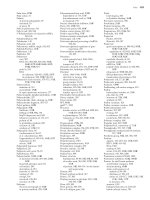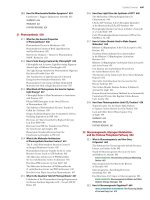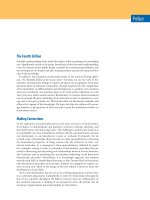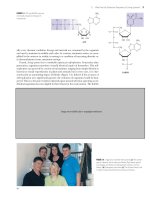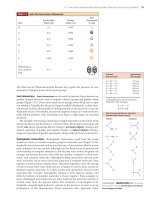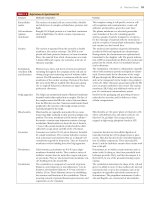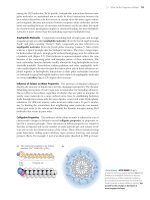Biochemistry, 4th Edition P24 docx
Bạn đang xem bản rút gọn của tài liệu. Xem và tải ngay bản đầy đủ của tài liệu tại đây (928.24 KB, 10 trang )
7.3 What Is the Structure and Chemistry of Oligosaccharides? 193
-
D-Lactose (O--D-galactopyranosyl-(1⎯→4)-D-glucopyranose) (Figure 7.18) is the
principal carbohydrate in milk and is of critical nutritional importance to mammals
in the early stages of their lives. It is formed from
D-galactose and D-glucose via a
(1⎯→4) link, and because it has a free anomeric carbon, it is capable of mutarotation
and is a reducing sugar. It is an interesting quirk of nature that lactose cannot be ab-
sorbed directly into the bloodstream. It must first be broken down into galactose and
glucose by lactase, an intestinal enzyme that exists in young, nursing mammals but is
not produced in significant quantities in the mature mammal. Most adult humans,
with the exception of certain groups in Africa and northern Europe, produce only
low levels of lactase. For most individuals, this is not a problem, but some cannot tol-
erate lactose and experience intestinal pain and diarrhea upon consumption of milk.
Sucrose, in contrast, is a disaccharide of almost universal appeal and tolerance.
Produced by many higher plants and commonly known as table sugar, it is one of the
products of photosynthesis and is composed of fructose and glucose. Sucrose has a
specific optical rotation, [␣]
D
20
, of ϩ66.5°, but an equimolar mixture of its compo-
nent monosaccharides has a net negative rotation ([␣]
D
20
of glucose is ϩ52.5° and
of fructose is Ϫ92°). Sucrose is hydrolyzed by the enzyme invertase, so named for
the inversion of optical rotation accompanying this reaction. Sucrose is also easily
hydrolyzed by dilute acid, apparently because the fructose in sucrose is in the rela-
tively unstable furanose form. Although sucrose and maltose are important to the
human diet, they are not taken up directly in the body. In a manner similar to lac-
tose, they are first hydrolyzed by sucrase and maltase, respectively, in the human
intestine.
A Variety of Higher Oligosaccharides Occur in Nature
In addition to the simple disaccharides, many other oligosaccharides are found in
both prokaryotic and eukaryotic organisms, either as naturally occurring sub-
stances or as hydrolysis products of natural materials.
Oligosaccharides also occur widely as components (via glycosidic bonds) of an-
tibiotics derived from various sources. Figure 7.19 shows the structures of two repre-
sentative carbohydrate-containing antibiotics.
A DEEPER LOOK
Trehalose—A Natural Protectant for Bugs
Insects use an open circulatory system to circulate hemolymph (in-
sect blood). The “blood sugar” is not glucose but rather trehalose,
an unusual, nonreducing disaccharide (see figure). Trehalose is
found typically in organisms that are naturally subject to tempera-
ture variations and other environmental stresses—bacterial spores,
fungi, yeast, and many insects. (Interestingly, honeybees do not
have trehalose in their hemolymph, perhaps because they practice
a colonial, rather than solitary, lifestyle. Bee colonies maintain a
rather constant temperature of 18°C, protecting the residents from
large temperature changes.)
What might explain this correlation between trehalose utiliza-
tion and environmentally stressful lifestyles? Konrad Bloch* sug-
gests that trehalose may act as a natural cryoprotectant. Freezing
and thawing of biological tissues frequently causes irreversible
structural changes, destroying biological activity. High concentra-
tions of polyhydroxy compounds, such as sucrose and glycerol, can
protect biological materials from such damage. Trehalose is par-
ticularly well suited for this purpose and has been shown to be su-
perior to other polyhydroxy compounds, especially at low concen-
trations. Support for this novel idea comes from studies by Paul
Attfield,
†
which show that trehalose levels in the yeast Saccharomyces
cerevisiae increase significantly during exposure to high salt and
high growth temperatures—the same conditions that elicit the
production of heat shock proteins!
OH
OHOH
OH
HO
HO
CH
2
OH
CH
2
OH
H
H
H
HH
HH
HH
H
O
O
O
*Bloch, K., 1994. Blondes in Venetian Paintings, the Nine-Banded Armadillo,
and Other Essays in Biochemistry. New Haven: Yale University Press.
†
Attfield, P. V., 1987. Trehalose accumulates in Saccharomyces cerevisiae dur-
ing exposure to agents that induce heat shock responses. FEBS Letters
225:259.
194 Chapter 7 Carbohydrates and the Glycoconjugates of Cell Surfaces
7.4 What Is the Structure and Chemistry of Polysaccharides?
Nomenclature for Polysaccharides Is Based on Their Composition
and Structure
By far the majority of carbohydrate material in nature occurs in the form of polysac-
charides. By our definition, polysaccharides include not only those substances com-
posed only of glycosidically linked sugar residues but also molecules that contain
polymeric saccharide structures linked via covalent bonds to amino acids, peptides,
proteins, lipids, and other structures.
Polysaccharides, also called glycans, consist of monosaccharides and their de-
rivatives. If a polysaccharide contains only one kind of monosaccharide molecule,
it is a homopolysaccharide, or homoglycan, whereas those containing more than
one kind of monosaccharide are heteropolysaccharides. The most common con-
stituent of polysaccharides is
D-glucose, but D-fructose, D-galactose, L-galactose,
D-mannose, L-arabinose, and D-xylose are also common. Common monosaccha-
ride derivatives in polysaccharides include the amino sugars (
D-glucosamine and
D-galactosamine), their derivatives (N-acetylneuraminic acid and N-acetylmuramic
acid), and simple sugar acids (glucuronic and iduronic acids). Polysaccharides dif-
fer not only in the nature of their component monosaccharides but also in the
length of their chains and in the amount of chain branching that occurs. Although
a given sugar residue has only one anomeric carbon and thus can form only one
glycosidic linkage with hydroxyl groups on other molecules, each sugar residue
carries several hydroxyls, one or more of which may be an acceptor of glycosyl sub-
stituents (Figure 7.20). This ability to form branched structures distinguishes poly-
saccharides from proteins and nucleic acids, which occur only as linear polymers.
Polysaccharides Serve Energy Storage, Structure,
and Protection Functions
Polysaccharides function as storage materials, structural components, or protective
substances. Thus, starch, glycogen, and other storage polysaccharides, as readily me-
tabolizable food, provide energy reserves for cells. Chitin and cellulose provide
strong support for the skeletons of arthropods and green plants, respectively.
Mucopolysaccharides, such as the hyaluronic acids, form protective coats on animal
cells. In each of these cases, the relevant polysaccharide is either a homopolymer
or a polymer of small repeating units. Recent research indicates, however, that
O
CH
3
H
3
C
HO
O
H
3
C
HO
CH
3
CH
3
OH
CH
3
O
O
H
OCH
3
CH
3
H
CH
3
H
HO
HH
O
O
H
N(CH
3
)
2
CH
3
H
HOH
H
HH
O
Erythromycin Streptomycin (a broad-spectrum antibiotic)
H
2
NCNH
NH
HO
OH
NHCNH
2
NH
HO
O
O
OH
CHO
H
3
C
O
HO
O
CH
2
OH
CH
3
NH
OH
FIGURE 7.19 Some antibiotics are oligosaccharides or contain oligosaccharide groups.
7.4 What Is the Structure and Chemistry of Polysaccharides? 195
oligosaccharides and polysaccharides with varied structures may also be involved in
much more sophisticated tasks in cells, including a variety of cellular recognition
and intercellular communication events, as discussed later.
Polysaccharides Provide Stores of Energy
Organisms store carbohydrates in the form of polysaccharides rather than as
monosaccharides to lower the osmotic pressure of the sugar reserves. Because os-
motic pressures depend only on numbers of molecules, the osmotic pressure is
greatly reduced by formation of a few polysaccharide molecules out of thousands
(or even millions) of monosaccharide units.
Starch By far the most common storage polysaccharide in plants is starch, which ex-
ists in two forms: ␣-amylose and amylopectin (Figure 7.20). Most forms of starch in
nature are 10% to 30% ␣-amylose and 70% to 90% amylopectin. ␣-Amylose is com-
posed of linear chains of
D-glucose in ␣(1⎯→4) linkages. The chains are of varying
length, having molecular weights from several thousand to half a million. As can be
seen from the structure in Figure 7.20, the chain has a reducing end and a nonre-
ducing end. Although poorly soluble in water, ␣-amylose forms micelles in which the
polysaccharide chain adopts a helical conformation (Figure 7.21). Iodine reacts with
␣-amylose to give a characteristic blue color, which arises from the insertion of iodine
into the middle of the hydrophobic amylose helix.
Amylopectin is a highly branched chain of glucose units (Figure 7.20). Branches
occur in these chains every 12 to 30 residues. The average branch length is between
24 and 30 residues, and molecular weights of amylopectin molecules can range up
to 100 million. The linear linkages in amylopectin are ␣(1⎯→4), whereas the branch
linkages are ␣(1⎯→6). As is the case for ␣-amylose, amylopectin forms micellar sus-
pensions in water; iodine reacts with such suspensions to produce a red-violet color.
Starch is stored in plant cells in the form of granules in the stroma of plastids
(plant cell organelles). When starch is to be mobilized and used by the plant that
stored it, it is split into its monosaccharide elements by stepwise phosphorolytic
cleavage of glucose units, a reaction catalyzed by starch phosphorylase (Figure
7.22). The products are one molecule of glucose-1-phosphate and a starch molecule
with one less glucose unit. In ␣-amylose, this process continues all along the chain
until the end is reached.
CH
2
OH
O
O
CH
2
OH
O
O
CH
2
OH
O
O
CH
2
OH
O
O
CH
2
OH
O
O
CH
2
OH
O
O
CH
2
OH
O
O
CH
2
OH
O
Amylose
O
CH
2
OH
O
O
CH
2
OH
O
O
CH
2
O
O
CH
2
OH
O
O
CH
2
OH
O
O
Am
y
lopectin
. . .
. . .
ANIMATED FIGURE 7.20 Amylose and amylopectin are the two forms of starch. Note that the
linear linkages are ␣(1⎯→4) but the branches in amylopectin are ␣(1⎯→6). Branches in polysaccharides can
involve any of the hydroxyl groups on the monosaccharide components.Amylopectin is a highly branched
structure, with branches occurring every 12 to 30 residues. See this figure animated at www.cengage.com/
login.
I
I
I
I
I
I
FIGURE 7.21 Suspensions of amylose in water adopt a
helical conformation. Iodine (I
2
) can insert into the mid-
dle of the amylose helix to give a blue color that is char-
acteristic and diagnostic for starch.
196 Chapter 7 Carbohydrates and the Glycoconjugates of Cell Surfaces
In animals, digestion and use of plant starches begin in the mouth with salivary
␣-amylase (␣(1⎯→4)-glucan 4-glucanohydrolase), the major enzyme secreted by the
salivary glands. Although the capability of making and secreting salivary ␣-amylases
is widespread in the animal world, some animals (such as cats, dogs, birds, and
horses) do not secrete them. Salivary ␣-amylase is an endoamylase that splits
␣(1⎯→4) glycosidic linkages only within the chain. Raw starch is not very susceptible
to salivary endoamylase. However, when suspensions of starch granules are heated,
the granules swell, taking up water and causing the polymers to become more ac-
cessible to enzymes. Thus, cooked starch is more digestible. Most starch digestion
occurs in the small intestine via glycohydrolases.
Glycogen The major form of storage polysaccharide in animals is glycogen. Glyco-
gen is found mainly in the liver (where it may amount to as much as 10% of liver
mass) and skeletal muscle (where it accounts for 1% to 2% of muscle mass). Liver
glycogen consists of granules containing highly branched molecules, with ␣(1⎯→6)
branches occurring every 8 to 12 glucose units. Like amylopectin, glycogen yields a
red-violet color with iodine. Glycogen can be hydrolyzed by both ␣- and -amylases,
yielding glucose and maltose, respectively, as products and can also be hydrolyzed
by glycogen phosphorylase, an enzyme present in liver and muscle tissue, to release
glucose-1-phosphate.
Dextran Another important family of storage polysaccharides is the dextrans,
which are ␣(1⎯→6)-linked polysaccharides of
D-glucose with branched chains found
in yeast and bacteria. Because the main polymer chain is ␣(1⎯→6) linked, the re-
peating unit is isomaltose, Glc␣1⎯→6Glc. The branch points may be 1⎯→2, 1⎯→3, or
1⎯→4 in various species. The degree of branching and the average chain length be-
tween branches depend on the species and strain of the organism. Bacteria growing
on the surfaces of teeth produce extracellular accumulations of dextrans, an impor-
tant component of dental plaque.
Polysaccharides Provide Physical Structure and Strength to Organisms
Cellulose The structural polysaccharides have properties that are dramatically dif-
ferent from those of the storage polysaccharides, even though the compositions of
these two classes are similar. The structural polysaccharide cellulose is the most abun-
dant natural polymer in the world. Found in the cell walls of nearly all plants, cellu-
lose is one of the principal components providing physical structure and strength.
The wood and bark of trees are insoluble, highly organized structures formed from
cellulose and also from lignin (see Figure 25.35). It is awe-inspiring to look at a large
tree and realize the amount of weight supported by polymeric structures derived from
sugars and organic alcohols. Cellulose also has its delicate side, however. Cotton,
CH
2
OH
O
O
CH
2
OH
O
O
CH
2
OH
O
O
CH
2
OH
O
HPO
4
2
–
Nonreducing end
CH
2
OH
O
CH
2
OH
O
O
CH
2
OH
O
O
CH
2
OH
O
+
OPO
3
2
–
n
n–1
Reducing endAmylose
␣-
D-Glucose-1-phosphate
OH
OH
ANIMATED FIGURE 7.22 The starch phosphorylase reaction cleaves glucose residues from
amylose, producing ␣-D-glucose-1-phosphate. See this figure animated at www.cengage.com/login.
7.4 What Is the Structure and Chemistry of Polysaccharides? 197
whose woven fibers make some of our most comfortable clothing fabrics, is almost
pure cellulose. Derivatives of cellulose have found wide use in our society. Cellulose
acetates are produced by the action of acetic anhydride on cellulose in the presence
of sulfuric acid and can be spun into a variety of fabrics with particular properties. Re-
ferred to simply as acetates, they have a silky appearance, a luxuriously soft feel, and a
deep luster and are used in dresses, lingerie, linings, and blouses.
Cellulose is a linear homopolymer of
D-glucose units, just as in ␣-amylose. The
structural difference, which completely alters the properties of the polymer, is that
in cellulose the glucose units are linked by (1⎯→4)-glycosidic bonds, whereas in
␣-amylose the linkage is ␣(1⎯→4). The conformational difference between these two
structures is shown in Figure 7.23. The ␣(1⎯→4)-linkage sites of amylose are natu-
rally bent, conferring a gradual turn to the polymer chain, which results in the he-
lical conformation already described (Figure 7.21). The most stable conformation
about the (1⎯→4) linkage involves alternating 180° flips of the glucose units along
the chain so that the chain adopts a fully extended conformation, referred to as an
extended ribbon. Juxtaposition of several such chains permits efficient interchain
hydrogen bonding, the basis of much of the strength of cellulose.
The structure of one form of cellulose, determined by X-ray and electron dif-
fraction data, is shown in Figure 7.24. The flattened sheets of the chains lie side
O
OH
OH
HO
O
O
OH
HO
OH
O
OH
OH
HO
O
O
-1,4-Linked
D-glucose units
(b)
O
OH
OH
HO
O
O
O
OH
O
OH
HO
␣-1,4-Linked
D-glucose units
(a)
O
FIGURE 7.23 (a) Amylose, composed exclusively of the relatively bent ␣(1⎯→4) linkages, prefers to adopt a
helical conformation, whereas (b) cellulose, with (1⎯→4)-glycosidic linkages, can adopt a fully extended con-
formation with alternating 180° flips of the glucose units.The hydrogen bonding inherent in such extended
structures is responsible for the great strength of tree trunks and other cellulose-based materials.
Intrachain
hydrogen
bond
Intersheet
hydrogen
bond
Interchain
hydrogen
bond
FIGURE 7.24 The structure of cellulose, showing the
hydrogen bonds (blue) between the sheets, which
strengthen the structure. Intrachain hydrogen bonds
are in red, and interchain hydrogen bonds are in green.
(Illustration: Irving Geis. Rights owned by Howard Hughes Med-
ical Institute. Not to be reproduced without permission.)
198 Chapter 7 Carbohydrates and the Glycoconjugates of Cell Surfaces
by side and are joined by hydrogen bonds. These sheets are laid on top of one
another in a way that staggers the chains, just as bricks are staggered to give
strength and stability to a wall. Cellulose is extremely resistant to hydrolysis,
whether by acid or by the digestive tract amylases described earlier. As a result,
most animals (including humans) cannot digest cellulose to any significant
degree. Ruminant animals, such as cattle, deer, giraffes, and camels, are an
exception because bacteria that live in the rumen (Figure 7.25) secrete the
enzyme cellulase, a -glucosidase effective in the hydrolysis of cellulose. The
resulting glucose is then metabolized in a fermentation process to the benefit of
the host animal. Termites and shipworms (Teredo navalis) similarly digest cellulose
because their digestive tracts also contain bacteria that secrete cellulase.
Chitin A polysaccharide that is similar to cellulose, both in its biological function
and its primary, secondary, and tertiary structure, is chitin. Chitin is present in the
cell walls of fungi and is the fundamental material in the exoskeletons of crustaceans,
insects, and spiders. The structure of chitin, an extended ribbon, is identical to that
of cellulose, except that the OOH group on each C-2 is replaced by ONHCOCH
3
,
so the repeating units are N-acetyl-
D-glucosamines in (1⎯→4) linkage. Like cellulose
(Figure 7.24), the chains of chitin form extended ribbons (Figure 7.26) and pack
side by side in a crystalline, strongly hydrogen-bonded form. One significant differ-
ence between cellulose and chitin is whether the chains are arranged in parallel (all
the reducing ends together at one end of a packed bundle and all the nonreducing
ends together at the other end) or antiparallel (each sheet of chains having the
chains arranged oppositely from the sheets above and below). Natural cellulose
seems to occur only in parallel arrangements. Chitin, however, can occur in three
forms, sometimes all in the same organism. ␣-Chitin is an all-parallel arrangement of
the chains, whereas -chitin is an antiparallel arrangement. In ␦-chitin, the structure
is thought to involve pairs of parallel sheets separated by single antiparallel sheets.
Chitin is the earth’s second most abundant carbohydrate polymer (after cellu-
lose), and its ready availability and abundance offer opportunities for industrial and
commercial applications. Chitin-based coatings can extend the shelf life of fruits,
and a chitin derivative that binds to iron atoms in meat has been found to slow the
reactions that cause rancidity and flavor loss. Without such a coating, the iron in
meats activates oxygen from the air, forming reactive free radicals that attack and
Esophagus
Omasum
Small intestine
Rumen
Abomasum
Reticulum
FIGURE 7.25 Giraffes, cattle, deer, and camels are rumi-
nant animals that are able to metabolize cellulose,
thanks to bacterial cellulase in the rumen, a large first
compartment in the stomach of a ruminant.
Cellulose
CO
CH
3
O
HO
HO
CH
2
OH
O
O
O
CH
2
OH
OH
HO
O
HO
HO
CH
2
OH
O
O
OH
HO
Chitin
O
HN
HO
CH
2
OH
O
O
NH
HO
O
HO
CH
2
OH
O
O
HO
CO
CH
3
HN
Mannan
O
HO
HO
CH
2
OH
O
O
HO
O
HO
CH
2
OH
O
O
HO
HO
N-Acetylglucosamine units
Mannose units
O
O
O
CO
CH
3
NH
CO
CH
3
O
CH
2
OH
O
CH
2
OH
O
CH
2
OH
O
CH
2
OH
HO
O
CH
2
OH
HO
ANIMATED FIGURE 7.26 Like
cellulose, chitin and mannan form extended rib-
bons and pack together efficiently, taking advan-
tage of multiple hydrogen bonds. See this
figure animated at www.cengage.com/login.
7.4 What Is the Structure and Chemistry of Polysaccharides? 199
A DEEPER LOOK
A Complex Polysaccharide in Red Wine—The Strange Story of Rhamnogalacturonan II
For many years, cotton and grape growers and other farmers have
known that boron is an essential trace element for their crops. Un-
til recently, however, the role or roles of boron in sustaining plant
growth were unknown. Recent reports show that at least one role
for boron in plants is that of crosslinking an unusual polysaccha-
ride called rhamnogalacturonan II (RGII). RGII is a low-molecular-
weight (5 to 10 kDa) polysaccharide, but it is thought to be the
most complex polysaccharide on earth, comprised as it is of 11 dif-
ferent sugar monomers. It can be released from plant cell walls by
treatment with a galacturonase, and it is also present in red wine.
Part of the structure of RGII is shown in the accompanying figure.
The nature of the borate ester crosslinks (also indicated in the fig-
ure) was elucidated by Malcolm O’Neill and his colleagues, who
used a combination of chemical methods and boron-11 NMR.
Why is rhamnogalacturonan II essential for the structure and
growth of plant walls? Plant walls are extremely sophisticated com-
posite materials, composed of networks of protein, polysaccha-
rides, and phenolic compounds. Cellulose microfibrils as strong as
steel provide a load-bearing framework for the plant. These mi-
crofibrils are tiny wires made of crystalline arrays of -1,4-linked
chains of glucose residues, which are extruded from hexameric
spinnerets in the plasma membrane of the plant cell, surrounding
the growing plant cell like hoops around a barrel. These micro-
fibrils thus constrain the directions of cell expansion and deter-
mine the shapes of the plant cells and the plant as well. The sepa-
ration of the barrel hoops is controlled by hemicelluloses, such as
xyloglucans, which form H-bonded crosslinks with the cellulose mi-
crofibrils. The hemicellulose network is embedded in a hydrated
gel inside the plant wall. This gel consists of complex galacturonic
acid–rich polysaccharides, including RGII—it provides a dynamic
operating environment for cell wall processes.
It is interesting to note that the tiny spinnerets of plant cells are
nature’s version of the viscose process, developed in 1910, for the
production of rayon fibers. In this process, viscose—literally
a viscous solution of cellulose—is forced through a spinneret (a de-
vice resembling a shower head with many tiny holes). Each hole
produces a fine filament of viscose. The fibers precipitate in an
acid bath and are stretched to form interchain H bonds that give
the filaments the properties essential for use as textile fibers.
OH
OH
OHOH
OH
OH
OC
OH
OH
OH
OH
OH
OH
CH
3
CH
2
CH
2
OH
CH
3
OH
HO
HO
CH
2
OH
CH
2
OH
CH
OH
C
C
C
C
O
CH
3
H
3
C
CH
3
O
O
O
O
O
O
O
؊
؊
؊
O
O
O
C
CH
3
O
C
CH
3
O
O
O
O
O
O
O
O
O
O
H
O
HO
HOHO
Site of boron attachment
RGII monomer
HO
HO
OOOO
O
O
O
O
O
O
O
O
O
O
O
O
O
O
O
O
O
O
O
O
O
O
O
O
O
O
O
O
O
O
C
؊
؊
O
O
؊
O
O
OH
CH
2
H
3
C
H
3
C
OH
OH
OH
HOCH
2
HO
HO
HO
HO
OH
OH
OH
HO
OH
OH
OH
OH
OH
OH
OH
OH
O
O
C
؊
O
O
O
C
؊
O
O
O
OH
OH
OH
OH
C
؊
O
O
O
O
HO
HCOH
C
؊
O
O
C
؊
O
O
O
C
؊
O
O
HO
O
C
؊
O
O
C
؊
O
O
C
؊
O
O
C
؊
O
O
O
CH
3
RGII dimer
O
Methyl groups
Acetyl groups
RGII dimer
B
Source: Hofte, H., 2001. A baroque residue in red wine. Science 294:795–797.
200 Chapter 7 Carbohydrates and the Glycoconjugates of Cell Surfaces
oxidize polyunsaturated lipids, causing most of the flavor loss associated with ran-
cidity. Chitin-based coatings coordinate the iron atoms, preventing their interaction
with oxygen.
Agarose An important polysaccharide mixture isolated from marine red algae
(Rhodophyceae) is agar, which consists of two components: agarose and agaropectin.
Agarose (Figure 7.27) is a chain of alternating
D-galactose and 3,6-anhydro-L-
galactose, with side chains of 6-methyl-
D-galactose. Agaropectin is similar, but in ad-
dition, it contains sulfate ester side chains and
D
-glucuronic acid. The three-
dimensional structure of agarose is a double helix with a threefold screw axis, as
shown in Figure 7.27. The central cavity is large enough to accommodate water
molecules. Agarose and agaropectin readily form gels containing large amounts
(up to 99.5%) of water.
Glycosaminoglycans A class of polysaccharides known as glycosaminoglycans is
involved in a variety of extracellular (and sometimes intracellular) functions. Gly-
cosaminoglycans consist of linear chains of repeating disaccharides in which one of
the monosaccharide units is an amino sugar and one (or both) of the monosac-
charide units contains at least one negatively charged sulfate or carboxylate group.
The repeating disaccharide structures found commonly in glycosaminoglycans are
shown in Figure 7.28. Heparin, with the highest net negative charge of the disac-
charides shown, is a natural anticoagulant substance. It binds strongly to antithrom-
bin III (a protein involved in terminating the clotting process) and inhibits blood
Agarose double helix
O
OH
HO O
O
CH
2
OH
O
O
O
HO
CH
2
3,6-Anhydro
bridge
n
A
garose
FIGURE 7.27 The favored conformation of agarose in
water is a double helix with a threefold screw axis.
HOH
O
OH H
H
H
H
COO
–
14
β
O
H NHCCH
3
O
H
H
–
O
3
SO
H
CH
2
OH
14
H
3
D-Glucuronate
N-Acetyl-
D-galactosamine-4-sulfate
Chondroitin-4-sulfate
H OSO
3
–
O
OH H
H
H
H
COO
–
14
α
H NHSO
3
–
O
H
H
H
CH
2
OSO
3
–
14
H
2
O
α
D-Glucuronate-
2-sulfate
N-Sulfo-
D-glucosamine-6-sulfate
Heparin
HOH
O
OH H
H
H
H
COO
–
14
H NHCCH
3
O
H
H
HO
H
CH
2
OSO
3
–
14
H
D-Glucuronate
N-Acetyl-
D-galactosamine-6-sulfate
Chondroitin-6-sulfate
HOH
O
OH H
H
H
H
COO
–
14
H NHCCH
3
O
H
H
H
H
CH
2
OH
1
HO
3
D-Glucuronate
N-Acetyl-
D-glucosamine
Hyaluronate
HOH
O
OH
H
COO
–
H
H
H
14
H NHCCH
3
O
H
H
–
O
3
SO
H
CH
2
OH
14
H
3
L-Iduronate
N-Acetyl-
D-
galactosamine-4-sulfate
Dermatan sulfate
HOH
O
H
H
HO
H
CH
2
OH
β
H NHCCH
3
O
H
H
H
H
CH
2
OSO
3
–
14
O
β
O
β
β
O
O
β
O
β
D-Galactose
N-Acetyl-
D-glucosamine-6-sulfate
Keratan sulfate
2
OH
OH
H
3
6
O
O
O
O
O
β
O
β
O
β
O
O
O
FIGURE 7.28 Glycosaminoglycans are formed from repeating disaccharide arrays. Glycosaminoglycans are
components of the proteoglycans.
7.4 What Is the Structure and Chemistry of Polysaccharides? 201
clotting. Hyaluronate molecules may consist of as many as 25,000 disaccharide
units, with molecular weights of up to 10
7
. Hyaluronates are important components
of the vitreous humor in the eye and of synovial fluid, the lubricant fluid of joints in
the body. The chondroitins and keratan sulfate are found in tendons, cartilage, and
other connective tissue; dermatan sulfate, as its name implies, is a component of the
extracellular matrix of skin. Glycosaminoglycans are fundamental constituents of
proteoglycans (discussed later).
Polysaccharides Provide Strength and Rigidity to Bacterial Cell Walls
Some of nature’s most interesting polysaccharide structures are found in bacterial
cell walls. Given the strength and rigidity provided by polysaccharide structures, it is
not surprising that bacteria use such structures to provide protection for their cel-
lular contents. Bacteria normally exhibit high internal osmotic pressures and fre-
quently encounter variable, often hypotonic exterior conditions. The rigid cell walls
synthesized by bacteria maintain cell shape and size and prevent swelling or shrink-
age that would inevitably accompany variations in solution osmotic strength.
Peptidoglycan Is the Polysaccharide of Bacterial Cell Walls
Bacteria are conveniently classified as either Gram-positive or Gram-negative de-
pending on their response to the so-called Gram stain. Despite substantial differ-
ences in the various structures surrounding these two types of cells, nearly all bac-
terial cell walls have a strong, protective peptide–polysaccharide layer called
peptidoglycan. Gram-positive bacteria have a thick (approximately 25 nm) cell wall
consisting of multiple layers of peptidoglycan. This thick cell wall surrounds the
bacterial plasma membrane. Gram-negative bacteria, in contrast, have a much thin-
ner (2 to 3 nm) cell wall consisting of a single layer of peptidoglycan sandwiched
between the inner and outer lipid bilayer membranes. In either case, peptidogly-
can, sometimes called murein (from the Latin murus, meaning “wall”), is a contin-
uous crosslinked structure—in essence, a single molecule—built around the cell.
The structure is shown in Figure 7.29. The backbone is a (1⎯→4)-linked polymer
A DEEPER LOOK
Billiard Balls, Exploding Teeth, and Dynamite—The Colorful History of Cellulose
Although humans cannot digest it and most people’s acquain-
tance with cellulose is limited to comfortable cotton clothing, cel-
lulose has enjoyed a colorful and varied history of utilization. In
1838, Théophile Pelouze in France found that paper or cotton
could be made explosive if dipped in concentrated nitric acid.
Christian Schönbein, a professor of chemistry at the University of
Basel, prepared “nitrocotton” in 1845 by dipping cotton in a mix-
ture of nitric and sulfuric acids and then washing the material to
remove excess acid. In 1860, Major E. Schultze of the Prussian
Army used the same material, now called guncotton, as a propel-
lant replacement for gunpowder, and its preparation in brass
cartridges quickly made it popular for this purpose. The only
problem was that it was too explosive and could detonate unpre-
dictably in factories where it was produced. The entire town of
Faversham, England, was destroyed in such an accident. In 1868,
Alfred Nobel mixed guncotton with ether and alcohol, thus
preparing nitrocellulose, and in turn mixed this with nitroglyc-
erin and sawdust to produce dynamite. Nobel’s income from
dynamite and also from his profitable development of the Russ-
ian oil fields in Baku eventually formed the endowment for the
Nobel Prizes.
In 1869, concerned over the precipitous decline (from hunt-
ing) of the elephant population in Africa, the billiard ball man-
ufacturers Phelan and Collander offered a prize of $10,000 for
production of a substitute for ivory. Brothers Isaiah and John
Hyatt in Albany, New York, produced a substitute for ivory by
mixing guncotton with camphor, then heating and squeezing it
to produce celluloid. This product found immediate uses well
beyond billiard balls. It was easy to shape, strong, and resilient,
and it exhibited a high tensile strength. Celluloid was eventually
used to make dolls, combs, musical instruments, fountain pens,
piano keys, and a variety of other products. The Hyatt brothers
eventually formed the Albany Dental Company to make false
teeth from celluloid. Because camphor was used in their pro-
duction, the company advertised that their teeth smelled “clean,”
but as reported in the New York Times in 1875, the teeth also oc-
casionally exploded!
Portions adapted from Burke, J., 1996. The Pinball Effect: How Renaissance
Water Gardens Made the Carburetor Possible and Other Journeys Through Knowledge.
New York: Little, Brown, & Company.
202 Chapter 7 Carbohydrates and the Glycoconjugates of Cell Surfaces
of N-acetylglucosamine and N-acetylmuramic acid units. This part of the structure
is similar to that of chitin, but it is joined to a tetrapeptide, usually
L-Ala и D-Glu и
L-Lys и D-Ala, in which the L-lysine is linked to the ␥-COOH of D-glutamate. The pep-
tide is linked to the N-acetylmuramic acid units via its
D-lactate moiety. The ⑀-amino
group of lysine in this peptide is linked to the OCOOH of
D-alanine of an adjacent
tetrapeptide. In Gram-negative cell walls, the lysine ⑀-amino group forms a direct
amide bond with this
D-alanine carboxyl (Figure 7.29). In Gram-positive cell walls, a
pentaglycine chain bridges the lysine ⑀-amino group and the
D-Ala carboxyl group.
Gram-negative cell walls are also covered with highly complex lipopolysaccharides
(Figure 7.30).
O
O
H
OH
CH
2
OH
H
H
H
NHCOCH
3
O
O
H
CH
2
OH
H
H
H
NHCOCH
3
O
H
3
CCHC
O
NH
O
CH CH
3
C
NH
O
CH COO
–
CH
2
CH
2
C
NH
O
CH (CH
2
)
4
N
H
C
NH
O
CH CH
3
COO
–
L-Ala
Isoglutamate
L-Lys
D-Ala
␥-Carboxyl linkage
to
L-Lys
HH
H
n
H
(c)
(b)
C
O
D-Ala
Gram-negative
C
O
D-Ala
Gram-
positive
N
H
)
5
CH
2
C
O
(
(NAG) (NAM)
(a)
(c)
Gram-negative cell wall
(b) Gram-positive cell wall
N-Acetylmuramic
acid (NAM)
L-Ala
D-Glu
L-Lys
D-Ala
Direct
crosslink
N-Acetylglucosamine
(NAG)
L-Ala
D-Glu
L-Lys
D-Ala
Pentaglycine
crosslink
FIGURE 7.29 (a) The structure of peptidoglycan.The tetrapeptides linking adjacent backbone chains contain an
unusual ␥-carboxyl linkage. (b) The crosslink in Gram-positive cell walls is a pentaglycine bridge. (c) In Gram-
negative cell walls, the linkage between the tetrapeptides of adjacent carbohydrate chains in peptidoglycan
involves a direct amide bond between the lysine side chain of one tetrapeptide and
D-alanine of the other.
